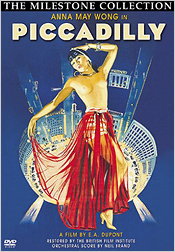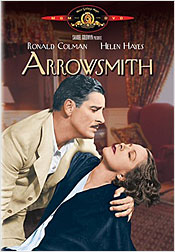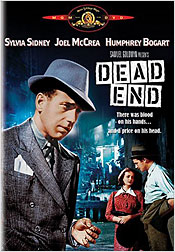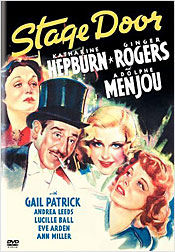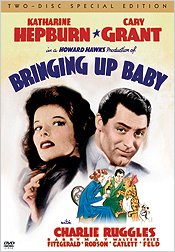 |
Site created 12/15/97.

page created: 3/15/05
 Barrie Maxwell - Main Page |
| Classic
Reviews Roundup #16 - March 2005 As I looked back over these reviews after writing them, I realized that there are an awful lot of recommendations here. But they're all justified. That's the sort of year it's been so far for fans of classic film on DVD - a case of money in, money out. As usual, the reviews are ordered by year of original theatrical release. There are 14 in all, ranging in original release date from 1922 to 1961. I hope you enjoy them. Grandma's Boy (1922) (released on DVD by Reelclassicdvd in March, 2004) In the early 1920s, the great sight-gag comedians began to make the transition from two-reelers to feature films. Keaton made The Saphead in 1920 and Chaplin made The Kid in 1921. In 1922, Harold Lloyd delivered his first two features - Grandma's Boy and Dr. Jack. Grandma's Boy is about a young man who is a coward when it comes to just about everything in his life. He can't evict a vagrant from his grandma's yard and he can't stand up for himself when another man tries to steal his girl. Taking pity on him, his grandma tells him about his grandfather - how he had been a coward during the Civil War until he was given a small charm that gave him the courage he lacked. She now passes the charm on to Harold and the transformation is amazing. |
| The
title is now in the public domain although it has not been made
widely available on DVD by the various PD specialists. The release
by Reelclassicdvd (available through reelclassicdvd.com) is a decent
presentation, pending a possibly superior release by New Line later
this year (as a result of an agreement with the Lloyd Trust to
release all the Lloyd films on DVD). The disc is quite watchable
although the image is rather washed out in many sequences and light
intensity fluctuates noticeably. Source material decomposition is
occasionally evident. The title cards are all readable and the film
is accompanied by a pleasing new score written and performed by Ben
Model. As a supplement, the disc includes the 1921 two-reel comedy
Lloyd comedy, I Do. It
originally was made as a three-reeler, but a preview was not a
success and its first reel was scrapped. The truncated version
became one of Lloyd's more successful shorts. Its presentation on
the disc, with a mainly sepia (almost yellow at times) tint, is
quite workable. Ben Model again provides the piano accompaniment. The Langdon Collection (1924-1926) (released on DVD by Reelclassicdvd in March, 2005) While several of Harry Langdon's feature-length efforts have been available on DVD for some time, his shorts are a different matter. Five of them from the period 1924 to 1926 have been gathered together for The Langdon Collection by Reelclassicdvd. Included are: Feet of Mud (1924), Lucky Stars (1925), Saturday Afternoon (1926), Fiddlesticks (1926), and Soldier Man (1926). All were made at the Mack Sennett Studios prior to Langdon's move into independent production released through First National. To my knowledge, only Saturday Afternoon has previously appeared on DVD (in Kino's Slapstick Encyclopedia). Feet of Mud - Harry is the surprise star of the football game, but then has to make good as a city street cleaner in order to win his girl's hand. Lucky Stars - Harry gets involved with a medicine show quack, but his troubles multiply when they settle in a Spanish town to do business. Saturday Afternoon - Harry is married, but still goes out on a double date with a friend. Of course, his wife eventually gets wind of it and the dates' former boyfriends show up too. Fiddlesticks - Harry tries to become a musician in order to make a living, but he can't play a lick. But playing badly can pay dividends too. Soldier Man - Harry is a soldier who doesn't know the war is over and eventually gets tangled up in a "Prisoner of Zenda" type situation. |
| The
DVD presentation is very pleasing indeed given the age of the
material. All five of the shorts look bright, fairly sharp, and
nicely detailed. Inevitably there are some sections that look soft
and there are numerous speckles and scratches, but they never
detract from one's enjoyment of the films. The shorts appear to be
complete, with opening credits intact and title cards in good shape.
Wurlitzer Theater organ music composed and played by Bernie Anderson
accompanies each short and is a definite plus. The disc offers a
play-all or play-individually option. Recommended. Piccadilly (1929) (released on DVD by Milestone on March 1st, 2005) Anna May Wong was born in Los Angeles in 1905 and eventually gravitated to film acting as a consequence of frequently seeing films shot in her neighborhood and through the influence of her cousin, James Wong Howe, then acting in films but eventually to become one of the foremost cinematographers of his time. First on screen about 1919 or 1920, she gradually improved her billing until by the mid-1920s, she had a reasonable fan following. Never completely satisfied with her Hollywood roles, however, she sought better opportunities in Europe during the transitional period from the silent to sound era. She returned to Hollywood and a contract with Paramount in the early 1930s (1932's Shanghai Express with Marlene Dietrich was a highpoint), but her roles diminished thereafter. It was during her European period that she appeared in one of her best films, Piccadilly, made in England by director E.A. Dupont and released in 1929. It was one of the last silent films to come out. |
| Piccadilly
was restored by the British Film Institute in 2003 to a 109-minute
length using a variety of source materials as the original negative
was badly decayed in many places. Milestone's full frame DVD
(distributed by Image) is a pleasure to behold. The image is very
clear and generally quite sharp. There is little evidence of source
material deterioration and the image is nicely tinted. The transfer
has potential for the PAL/NTSC ghosting that can occur in such
instances, but I found no problems of significance in my viewing.
The musical accompaniment by Neil Brand is a sort of jazz/swing
score that is quite appealing even if it could be argued that it
doesn't sound quite as contemporary with the 1929 release date as it
could be. The supplements include the prologue that was used for a
sound version of the film that was made available soon after the
original silent release; a 20-minute discussion of the score by its
composer; 22 minutes of excerpts from a film festival panel
discussion on Anna May Wong that are quite interesting (at least the
portions that one can hear - the sound is very poor); a stills
gallery; and DVD-ROM material that includes press information and
five essays on Anna May Wong. Recommended. Arrowsmith (1931) (released on DVD by MGM on March 8th, 2005) Sinclair Lewis's novel "Arrowsmith" was written in 1925 and became a huge popular and critical success, eventually winning a Pulitzer Prize for that year. It told the story of Martin Arrowsmith, a young doctor interested in research who begins his career as a country practitioner after marrying a young nurse named Leora Tozer. Despite the pleasures of a rural practice, Arrowsmith never loses his interest in research and after developing a cure for Black Leg disease in cattle, he is eventually lured to New York by the prospect of doing important medical research at the prestigious McGurk Institute. There research progress is slow, but eventually he develops a promising serum. When news of a plague outbreak on an island in the West Indies arrives, Arrowsmith travels there to test his serum, with Leora accompanying him. Unfortunately the plague situation is even worse than he expected and Arrowsmith's whole life is irrevocably changed by the events that follow. |
| MGM
has released the film on DVD in a full frame transfer that is
consistent with the original aspect ratio. The results are somewhat
inconsistent as the image varies from being sharp and bright to
occasionally pale and fuzzy. Modest grain is in evidence and
sometimes the DVD encoding accentuates it excessively. When the
image is good (which admittedly is most of the time), the blacks are
quite deep and image detail is fine. The mono sound provides clear
dialogue although low-level background hiss is present. English,
French, and Spanish subtitles are provided. There are no
supplements. Despite the film's shortcomings, its ambition along
with its acting and directorial pedigree make a rental not
unreasonable. Dead End (1937) (released on DVD by MGM on March 8th, 2005) It's always nice to get more Bogart on DVD and here we have one of his few non-Warners appearances during the late 1930s. The film is Dead End, based on the play of the same title by Sidney Kingsley which ran on Broadway for well over a year. Although Fox and RKO were interested in filming the play, it was Samuel Goldwyn who purchased the screen rights for his independent production company. Some of the Broadway cast recreated their roles on the screen including Marjorie Main and several of the group of juveniles that would soon come to be billed as the Dead End kids (Billy Halop, Huntz Hall, Gabriel Dell, and Bernard Punsley). Leo Gorsey also appeared, though in a somewhat different role compared to the one he played on stage. For the film's lead roles, Goldwyn used Joel McCrea (who was already under contract to him), and Sylvia Sidney and Humphrey Bogart (borrowed from Walter Wanger and Warner Bros. respectively). |
| The
film was directed by William Wyler who got his accustomed good
performances from the actors, but his efforts were dwarfed by the
impressive tenement set that was constructed on a Hollywood sound
stage. It apparently was viewed as quite an accomplishment at the
time, even surpassing the impressiveness of the one constructed in
the theatre where the stage version of the play was mounted. Wyler
had wanted to film on location, but was over-ruled by Goldwyn. In
this instance, Wyler would have been right. Even though the set was
impressive in scope, it never rings completely true on the screen,
preventing the film from achieving its full potential. The film was
nominated for four Academy Awards (picture, supporting actress
[Trevor], cinematography, and art direction), but didn't win any. MGM's DVD release presents the film full frame in accord with its original aspect ratio. The image looks tremendous reflecting impressive source material. It's crisp with a very fine gray scale range in evidence. Speckles and scratches are virtually non-existent and there are no edge effects. The mono sound is clear and free of hiss. There's also a Spanish mono track and English, French, and Spanish sub-titles. The only supplement is the film's theatrical trailer. Recommended. Stage Door (1937) (released on DVD by Warner Bros. on March 1st, 2005) This RKO production is one of those ensemble pieces that really works well. Based on the Edna Ferber/George S. Kaufman play of the same title, though apparently considerably altered for the screen version, it's a great showcase for such wise-cracking actresses as Ginger Rogers, Eve Arden, and Lucille Ball, as well as the then-somewhat-tarnished star of Katharine Hepburn. Also appearing are the likes of Gail Patrick and Ann Miller (in a very early role). |
| The
full frame transfer is impressive. Either the source material is in
very good shape or Warners has done a thorough job of cleaning it up
for its DVD release. The image has nice deep black levels and very
good shadow detail. Contrast is excellent. There is modest grain in
evidence. The mono sound is in great shape with virtually no
age-related hiss or crackle evident. English, French, and Spanish
sub-titles are provided. The supplements consist of a 1939 Lux Radio
Theater dramatization of the film with Ginger Rogers and Rosalind
Russell, the Vitaphone musical short Ups
and Downs of modest entertainment value though worthwhile
for the opportunity to see early work by Phil Silvers and June
Allyson, and the film's theatrical trailer. Highly recommended. Bringing Up Baby (1938) (released on DVD by Warner Bros. on March 1st, 2005) It seems almost impossible to conceive of the fact that when originally released in 1938, Howard Hawks's Bringing Up Baby was not a box-office success. In fact, it was at that time the final nail in a temporary coffin for Katharine Hepburn's film career. She retreated to the New York stage for several years before returning to the screen triumphantly in 1940's The Philadelphia Story. Howard Hawks was the director of Bringing Up Baby because he was casting about for a project to undertake while casting and budgetary issues delayed Gunga Din, another film project that he hoped to direct. (That job eventually went to George Stevens.) The film originated in a short story in "Collier's" magazine by Hagar Wilde that Hawks liked. It concerned a paleontologist who hopes to convince a rich society patron to invest $1 million in the museum where he is on the verge of completing the erection of an immense dinosaur skeleton with the discovery of the final crucial bone - the intercostal clavicle. Unfortunately, his best efforts are continually thwarted by a young heiress, a dog named George, and particularly a leopard named Baby. That's a rather thin description of the story, but the comedic complications have to be seen to be believed. |
| Warner
Bros.'s DVD release is a two-disc special edition. Disc One contains
a very fine transfer of the film presented full frame in accord with
the original aspect ratio. The film's source material was in pretty
poor condition so a significant amount of restorative work was
needed. The resulting effort has been worth the lengthy wait. For
the most part the image is quite sharp with deep blacks, clean
whites, and very good shadow detail. The film's natural grain is in
evidence providing the image with a nice film-like impression. Some
minor speckling is detectable, but not at all intrusive. That and an
oocasional instance of softness are the only things that prevent
this from being a homerun. The English mono sound is in good shape,
with clear dialogue although there is a some background hiss
evident. English, French, and Spanish sub-titles are also provided.
Peter Bogdanovich provides a thorough audio commentary. I know
people have mixed reactions to his commentaries, but I find them to
be very good in terms of providing an understanding of directorial
technique and a general overview of the pertinent production
details. That's the case here. The first disc concludes with a
gallery of five trailers for Howard Hawks films including Bringing
Up Baby. Disc Two contains two very impressive documentaries. The first is the feature-length Cary Grant: A Man Apart produced by Robert Trachtenberg for TCM. At almost an hour and a half in length, it gives as thorough a portrait of an actor's life as I've seen. Then there's the Howard Hawks documentary in the "Men Who Made the Movies" series. Lasting almost an hour, it provides some marvelous recollections and opinions from Hawks himself on his career, nicely scripted by Richard Schickel and narrated by Sydney Pollack. Rounding out the disc are two 1938 Technicolor shorts - a Vitaphone effort called Campus Cinderella and the cartoon A Star Is Hatched. Very highly recommended. |
On to Part Two
Barrie Maxwell - Main Page
 |
| Site
designed for 1024 x 768 resolution, using 16M colors and .gif 89a
animation. © 1997-2015 The Digital Bits, Inc., All Rights Reserved. billhunt@thedigitalbits.com |

